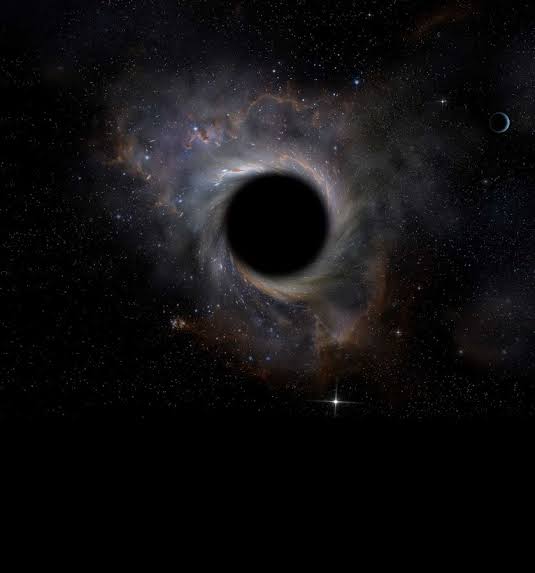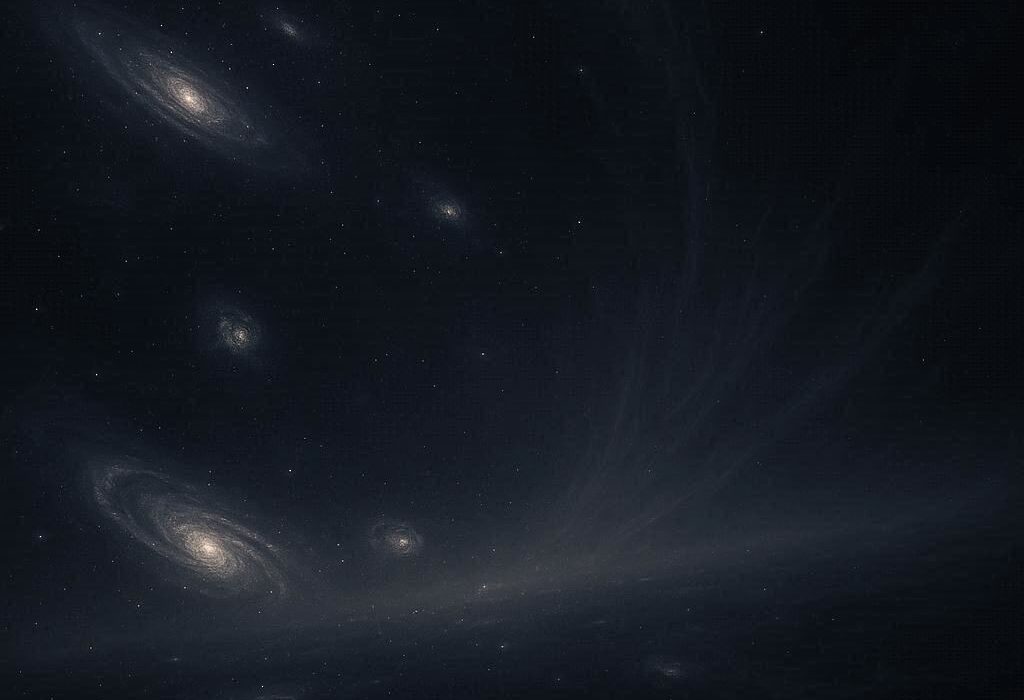In the vast stage of the cosmos, there are places where the ordinary rules of existence collapse, where light itself is caught and never released. These are black holes—cosmic abysses so mysterious, so powerful, that even our boldest imaginations struggle to grasp their reality. To speak of a black hole is to stand on the edge of human knowledge, staring into a frontier where physics as we know it unravels. And at the heart of every black hole lies its defining feature: the event horizon.
The event horizon is not a physical surface like the crust of a planet, nor is it a tangible wall that one might touch. It is, instead, a boundary—a one-way threshold into oblivion. Once crossed, there is no return. It is a point beyond which escape becomes impossible, not because of weakness, but because the very fabric of space and time itself is bent into an inescapable funnel. To understand black holes is to begin here, at this strange horizon, and then dare to ask the most unsettling question: what happens past it?
The Birth of Darkness
Black holes begin not as eternal voids but as stars—massive, burning, brilliant stars. For millions of years, these stellar giants live in a delicate balance, their immense gravity pulling inward while nuclear fusion pushes outward, releasing energy that shines across the cosmos. Yet even stars have lifespans, and when the fuel is exhausted, gravity wins the final battle. The star collapses in on itself, crushing its own matter into unimaginable density.
For stars more than about twenty times the mass of our Sun, this collapse does not stop with a neutron star. Instead, the inward fall continues until nothing can halt it. Matter compresses to a point of infinite density, a singularity. Around that singularity, space-time itself caves in, forming a black hole. This is no longer a star. It is the most extreme object in the universe, where gravity is so absolute that even light cannot escape.
From a distance, the black hole appears deceptively simple—a sphere of darkness surrounded by brilliant accretion disks of hot gas spiraling inward. But up close, its true nature emerges. It has no surface, no edge in the traditional sense. Instead, it has the event horizon. Beyond this horizon lies a world forever hidden from us, sealed off not by distance but by the laws of physics themselves.
The Event Horizon: Point of No Return
Imagine falling toward a black hole. At first, the experience might be deceptively ordinary. Stars still shine above, your ship still functions, and even though you are being pulled inward, you might not immediately sense anything unusual. But as you approach closer, the warping of space-time grows severe. Time itself begins to behave strangely.
From the perspective of a distant observer—say, someone watching you fall from a safe orbit—you would appear to slow down as you approached the event horizon. Your signals would stretch into longer and longer wavelengths, your image fading into redder tones until it disappeared altogether. To that observer, you would never quite cross the horizon; you would hover, frozen in time, fading into darkness.
But your own experience would be utterly different. To you, time flows normally. You would fall through the horizon in a finite time, without noticing any barrier. One moment, the outside universe is visible; the next, it is forever cut off. The event horizon is silent, invisible, and merciless. Passing through it feels like crossing any ordinary patch of space, but the consequences are eternal: escape is impossible.
Spaghettification and the Tidal Grip
The closer one ventures to a black hole, the stronger its gravitational pull becomes. This is not unusual—gravity strengthens with proximity everywhere in the universe. But what makes black holes so terrifying is the gradient of this pull, the difference in gravity between one part of an object and another.
Suppose you are falling feet-first toward a black hole. Your feet are closer to the singularity than your head. The gravitational pull on your feet is vastly stronger than on your head. This difference stretches you like a piece of dough. The process has a gruesome nickname: spaghettification. Your body, and indeed any object, would be elongated and compressed into a thin thread, pulled apart molecule by molecule.
For stellar-mass black holes—those a few times larger than our Sun—this spaghettification would occur well before you even reached the event horizon. You would be shredded long before crossing that fatal boundary. But for supermassive black holes, millions or billions of times the Sun’s mass, the story is different. Their horizons are so vast that tidal forces at the boundary are gentle. You could drift across without immediate destruction, only to meet your end closer to the singularity itself. The size of the black hole determines the drama of the fall, but in all cases, the final fate is unavoidable.
Past the Horizon: A One-Way Journey
Once you cross the event horizon, the geometry of space and time changes fundamentally. Outside the horizon, you may choose your direction—forward, backward, left, right. Inside, every possible direction you move leads deeper toward the singularity. Time itself bends so that falling inward becomes as inevitable as moving forward in time. Just as we cannot stop aging or reverse the flow of seconds, once inside the horizon, you cannot stop falling toward the center.
This means that the singularity is not merely a place you might reach. It is, in a sense, your future. Just as tomorrow lies ahead no matter what choices you make, the singularity lies ahead for everything that crosses the horizon. It is not a question of if you will reach it, but when. And when you do, all known laws of physics collapse.
The Singularity: End of Physics as We Know It
At the core of a black hole lies the singularity, a point of infinite density where matter is crushed to zero volume and gravity becomes immeasurable. General relativity predicts its existence with mathematical certainty, but here lies a paradox: physics itself cannot function at infinity. Equations diverge, predictions lose meaning, and our understanding reaches a dead end.
What does it mean to encounter a singularity? Does matter truly collapse to an infinitely small point? Or is this a signal that our current theories are incomplete, that a deeper, undiscovered framework—perhaps a theory of quantum gravity—must take over? Many physicists believe that singularities do not physically exist as points, but rather as places where relativity breaks down, giving way to quantum phenomena beyond our present grasp.
Yet for anything that falls inward, the singularity is the final destination. There is no avoiding it, no stable orbit within, no escape route. All paths lead inexorably to this center of unknowability. If the event horizon is a silent gate, the singularity is the cosmic abyss at its heart.
Time’s Stranger Face
One of the most haunting features of black holes is their relationship with time. Outside the horizon, time is stretched by gravity. A clock near the event horizon ticks more slowly than one far away. This effect, called gravitational time dilation, is not speculation—it has been measured with precise instruments even near Earth. Near a black hole, however, this stretching becomes extreme.
For an external observer, watching someone fall toward a black hole is like watching them freeze at the edge of time. Their last moments play out infinitely slowly, stretched across eternity. From the inside, however, the fall happens in a flash. Hours or minutes might pass for the falling traveler while eons unfold in the outside universe. This disconnect between perspectives makes black holes not only physical traps but temporal ones. To enter is to step out of the shared time of the universe, into a private timeline that ends at the singularity.
Do Black Holes Destroy Information?
One of the greatest mysteries of modern physics is the information paradox. When matter falls into a black hole, what happens to the information describing it? In physics, information is not just a casual idea—it is the set of properties that define a system. The arrangement of atoms, the quantum states of particles, the details that distinguish one object from another. According to quantum mechanics, information cannot be destroyed. But black holes seem to obliterate it.
If everything that crosses the horizon is crushed at the singularity, the unique information it carried appears lost forever. Yet this contradicts the laws of quantum theory. The paradox has fueled decades of debate. Some suggest that information might be encoded on the surface of the event horizon itself, preserved in a holographic imprint. Others propose that Hawking radiation, the faint glow of particles emitted by black holes, slowly carries information back into the universe. The question remains one of the most profound puzzles in science, sitting at the crossroads of relativity and quantum mechanics.
The Whisper of Hawking Radiation
In the 1970s, physicist Stephen Hawking made a startling discovery. Black holes, long thought to be eternal consumers, may actually evaporate. Through quantum effects near the event horizon, pairs of virtual particles constantly flicker in and out of existence. Normally, they annihilate each other instantly. But at the horizon, one particle may fall in while the other escapes. To an outside observer, it appears as though the black hole itself is emitting radiation.
This radiation, now known as Hawking radiation, carries away energy, causing the black hole to lose mass over immense spans of time. For stellar and supermassive black holes, this process is glacial, far longer than the age of the universe. But for tiny black holes, the evaporation could be rapid and dramatic. The existence of Hawking radiation ties together quantum mechanics, relativity, and thermodynamics, suggesting that black holes are not just destroyers but participants in the balance of cosmic energy.
The fate of information may lie here as well. If radiation carries subtle imprints of what fell in, then perhaps black holes are not prisons of information but cryptic vaults slowly unlocking their secrets. The universe, it seems, may not allow its stories to be erased entirely.
Wormholes and Other Speculations
Einstein’s equations do not forbid strange possibilities within black holes. The mathematics allows for the idea of wormholes—bridges through space-time connecting distant regions or even other universes. Could the singularity be not an end, but a passage? Might black holes serve as tunnels, linking realms beyond our perception?
These ideas ignite the imagination but remain speculative. Most physicists believe that the violent collapse within black holes would destroy such pathways instantly. Yet the allure of black holes as portals persists in science and fiction alike, a reminder of how little we truly know about the heart of these cosmic enigmas.
The Human Connection
Though black holes exist light-years away, their mystery speaks deeply to us as humans. They embody both fear and wonder, destruction and creation. They remind us of the limits of knowledge, daring us to push beyond them. And they place us in perspective: tiny creatures on a small planet, gazing into abysses that dwarf imagination itself.
Black holes are not merely astrophysical curiosities. They are laboratories of truth, testing grounds for the deepest questions of existence. What is the nature of space and time? Can information ever truly vanish? Is reality continuous or discrete at its most fundamental level? Each black hole is a cosmic riddle, and in seeking its solution, we may uncover not only the secrets of the universe but also the nature of reality itself.
Into the Silence
To step past the event horizon is to enter a world we cannot return from, a world hidden from all observers. For the traveler, it is a journey into inevitability. For the universe, it is a challenge to understanding. At the boundary where light dies and time bends, human imagination strains to keep pace.
Yet there is beauty in this darkness. For black holes are not just destroyers but creators of knowledge. They demand of us humility, wonder, and courage. And in asking what happens past the event horizon, we are not merely probing physics—we are touching the edges of philosophy, of meaning, of existence itself.
The truth is that no one knows exactly what happens beyond that point of no return. The singularity remains shrouded in mystery, the laws of physics faltering at its feet. But perhaps the very act of asking, of daring to peer into the darkness, is the most human thing we can do. For as long as we question, the horizon will not be the end. It will be the beginning.






